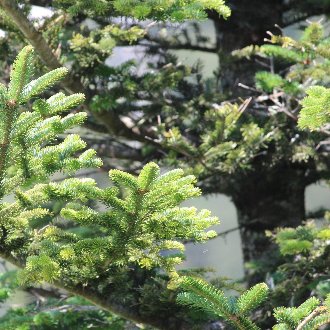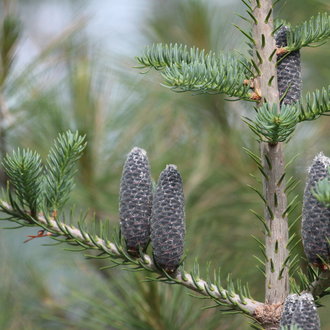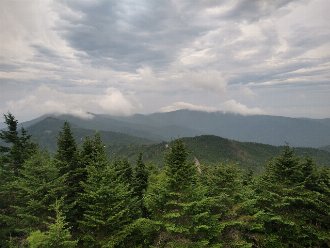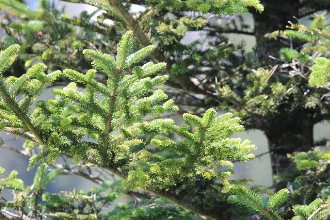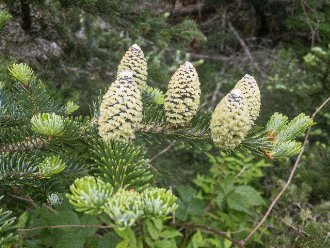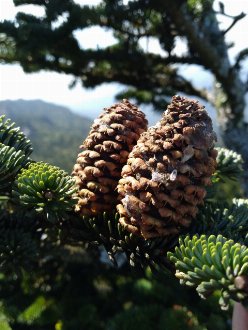Fraser Fir (Abies fraseri (Pursh) Poir.)
↑Summary
A conifer limited to late successional stages of forests at high elevations in the southern Appalachians; endangered due to a variety of factors.
↑Similar Plants
↑Habitat
Found at high elevations in the southern Appalachians, in a region with very high precipitation (75 to 100 inches annually) and persistent fog for about 65% of the growing season.
Mostly found above 5,500 feet (1,676 m) in elevation, but occasional to 4,500 feet (1,372 m) where it is limited to north-facing slopes and protected coves. At lowest elevations it is a minor component of the forest, and increasing in elevation, it becomes an increasingly large component of spruce-fir forests, whereas at the highest elevations it forms nearly-pure stands.
Usually found on sites with shallow, rocky soil, usually with bedrock within 20-32 inches of the surface. In the wild, mostly restricted to sites with highly acidic soils; one site with this species codominant with red spruce had a pH of 3.6 at the surface and 3.8 at a depth of 15 inches. It is not clear whether pH is a limiting factor of this species dominance, or whether low pH is a result of the other conditions associated with its dominance, including high rainfall and accumulation of acidic needle litter. Although this species can grow on sites with pH as high as 5.8, it may not compete favorably with other vegetation on these sites.
Found in late successional stages of forests where it occurs, and persists indefinitely in these forests. This species can colonize small gaps, and can even regenerate following major insect damage that weakens the canopy and kills a large portion of the forest over a period of several years, but it does not colonize sites following a concentrated canopy-destroying disturbance such as a major fire or clearcutting. In these cases it recolonizes such sites only later, following the establishment of other vegetation, usually deciduous trees.
This species' habitat is decreasing due to global warming pushing its climate zone to progressively higher elevations, and it also faces pressure due to introduced insects, and possibly increased stress due to acid rain and higher UV radiation from ozone depletion. It has become endangered as a result.
↑Life Cycle
Fraser fir is a relatively short-lived conifer that inhabits late stages of succession in its upper montane habitat.
Seeds germinate readily on any surface, including mineral soil and decaying wood, but establishment is best when seedlings establish on moss or peat; seedlings establishing in litter are more likely to die during a dry spell. It is not apparent whether moss aids seedling survival, or is simply an indicator of microclimates with higher moisture levels that aid seedling survival. The requirements for some shelter and higher ground-level moisture may be what limits this species to later successional stages.
Trees suppressed by shade grow extraordinarily slowly, but can often survive indefinitely; such trees may be as little as 2 feet tall after 20 years. On the other hand, trees exposed to full sun can grow faster, reaching heights of 8.2 feet after only 11 years. In its native habitat, trees regenerate most in gaps created by windthrow.
On a typical tree, seed production begins around 15 years of age. Good seed crops are usually produced every other year, with light crops in other years. Some seeds mature by the end of August but most seeds mature in September, some possibly slightly later. Seeds are primarily dispersed by wind: seeds can be carried up to a mile from the parent tree, and about half of them travel at least 900 feet. In masting years, seed viability is high, whereas in off years, a greater portion of seeds are consumed by insects. It is not known whether the seeds persist long-term in the seed bank, but it is likely that they do not; seeds of the closely related balsam fir (Abies balsamea) do not stay viable beyond the first year.
Trees live an average of 150 years. Causes of death can include heart rot, root rot, insect damage, and windthrow. Nowadays the largest cause of mortality is the Balsam woolly adelgids (Adelges piceae), introduced from Europe and first recorded in North America in 1957, and causing extensive mortality since the 1960's.
Trees can reproduce vegetatively by layering, when lower branches become buried in moist soil. This happens only rarely in the wild, however, and is not an important reproductive mechanism. Trees do not resprout after being top-killed.
↑Faunal Associations
The American red squirrel (Tamiasciurus hudsonicus), which reaches its southern range limits in this tree's range, eats the seeds and buds.
The minute wasp Megastigmus specularis consumes the seeds. The foliage is only occasionally browsed by deer. The polyphagous red spider mite (Tetranychus urticae), introduced from Europe, also eats this species, but generally does not cause severe damage. The introduced balsam woolly adelgid preferentially eats this species and balsam fir, and causes significant mortality.
↑Uses
This species is sometimes planted as an ornamental or landscaping plant. Its use in landscaping is limited by its poor tolerance of hot, humid summers; it is also intolerant of poor drainage, high pH soils, and urban pollution. In landscaping, it grows best in or near its native range, and when slightly outside of it, when planted on cool, humid, shaded sites such as north-facing slopes or the north side of a building.
There is at least one cultivar, 'Kline's Nest', which has a mat-forming habit reaching at most 4 feet in height.
The most well-known use of Douglas fir is for Christmas trees, for which it is widely planted in plantations. It has been the most common species used as the White House Christmas tree.
This species is not used for timber, due to its restricted range and generally being limited to difficult-to-access sites.
This species has been planted for watershed protection, especially in and near its native range, where it is valued for its ability to establish on steep slopes and effectively anchor the soil in regions with high rainfall. They are also seen as a scenic attraction, as their occurence on prominent peaks makes them highly visible, and they have a form generally considered attractive.
↑Related Plants
Fraser fir is most closely related to balsam fir (Abies balsamea). The species do not hybridize in nature, because their ranges do not overlap, but they can be interbred artificially. However, some authors treat the southernmost populations of Balsam fir, Abies balsamea var. phanerolepis, located in West Virginia and Virginia, as a hybrid of the two species.
It has been proposed, and seems likely, that Fraser fir and Balsam fir originated as a single species with clinal variation along the northeast-southeast corridor of the Appalachians, and the populations became reproductively isolated as the climate warmed in the most recent interglacial period, leading to speciation when a large gap formed between the population that is now considered Fraser fir and the southernmost population of Balsam fir. However, there is already a somewhat smaller gap between that population and the rest of Balsam fir, which has a largely connected population, and it can be subjective what is considered separate species vs. a hybrid vs. a single species with variation.
Other than balsam fir, there are no other native members of the Abies genus anywhere near its range, but the European silver fir (Abies alba) has been introduced into a small portion of this species range, and the momi fir (Abies firma) has been introduced very close to this species range. Numerous other fir species occur in North America, but they are limited to the west. Of these, the closest related is probably the subalpine fir (Abies lasiocarpa), whose range is restricted to the west coast.
↑Links & External Resources
• Fraser Fir | Fire Effects Information System (FEIS) (About This Site)
• Abies fraseri (Fraser Fir) | USDA PLANTS Database (About This Site)
• Fraser Fir | iNaturalist (About This Site)
• Abies fraseri (Fraser Fir) | Missouri Botanical Garden Plant Finder (About This Site)
• Fraser Fir | Virginia Tech Dendrology Factsheets (About This Site)
• Fraser Fir | Silvics of North America (About This Site)
• Abies fraseri | Biota of North America Project (BONAP) (About This Site)
• Abies fraseri | NatureServe Explorer (About This Site)
• Abies fraseri | Flora of North America (About This Site)
• Abies fraseri (Pursh) Poiret (Fraser Fir, Southern Balsam) | Digital Atlas of the Virginia Flora (About This Site)



